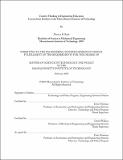| dc.contributor.advisor | Dava Newman and David Wallace. | en_US |
| dc.contributor.author | Rush, Monica R | en_US |
| dc.contributor.other | Massachusetts Institute of Technology. Technology and Policy Program. | en_US |
| dc.date.accessioned | 2010-03-24T20:34:07Z | |
| dc.date.available | 2010-03-24T20:34:07Z | |
| dc.date.copyright | 2009 | en_US |
| dc.date.issued | 2009 | en_US |
| dc.identifier.uri | http://hdl.handle.net/1721.1/52753 | |
| dc.description | Thesis (S.M. in Technology and Policy)--Massachusetts Institute of Technology, Engineering Systems Division, Technology and Policy Program, 2009. | en_US |
| dc.description | This electronic version was submitted by the student author. The certified thesis is available in the Institute Archives and Special Collections. | en_US |
| dc.description | Includes bibliographical references (p. 80-83). | en_US |
| dc.description.abstract | Engineers have deemed creative thinking a necessary skill in their line of work, and ABET, the accreditation board for engineering schools, can evaluate a program based on how it attempts to teach it in its courses. And yet, many students and professors feel that creative thinking is a skill often overlooked by the traditional engineering curriculum. This thesis investigates student acquisition of creative thinking skills in four engineering design courses taught under the Mechanical Engineering and the Aeronautics/Astronautics Departments at the Massachusetts Institute of Technology. Quantitative research methods (surveys, assessments) and qualitative methods (interviews, focus groups) are combined to identify factors that influence student creativity in the classroom and retention and use of creative thinking skills beyond the classroom. Student reflections are used to tie theories of creativity with educational theory on student learning. Common themes discussed by students in relation to creativity include the interactive lecture and lab environments, the involvement of the professors and confidence and hands-on practice. Data shows the relationship between perceptions of team creativity and individual creative development. Recommendations on course structure and supportive institutional policies encouraging creative classroom environments are made based on the experiences of the students and teaching staff of these courses. | en_US |
| dc.description.statementofresponsibility | by Monica R. Rush. | en_US |
| dc.format.extent | 83 p. | en_US |
| dc.language.iso | eng | en_US |
| dc.publisher | Massachusetts Institute of Technology | en_US |
| dc.rights | M.I.T. theses are protected by
copyright. They may be viewed from this source for any purpose, but
reproduction or distribution in any format is prohibited without written
permission. See provided URL for inquiries about permission. | en_US |
| dc.rights.uri | http://dspace.mit.edu/handle/1721.1/7582 | en_US |
| dc.subject | Engineering Systems Division. | en_US |
| dc.subject | Technology and Policy Program. | en_US |
| dc.title | Creative thinking in engineering education : lessons from students at the Massachusetts Institute of Technology | en_US |
| dc.type | Thesis | en_US |
| dc.description.degree | S.M.in Technology and Policy | en_US |
| dc.contributor.department | Massachusetts Institute of Technology. Engineering Systems Division | |
| dc.contributor.department | Technology and Policy Program | |
| dc.identifier.oclc | 501810064 | en_US |
